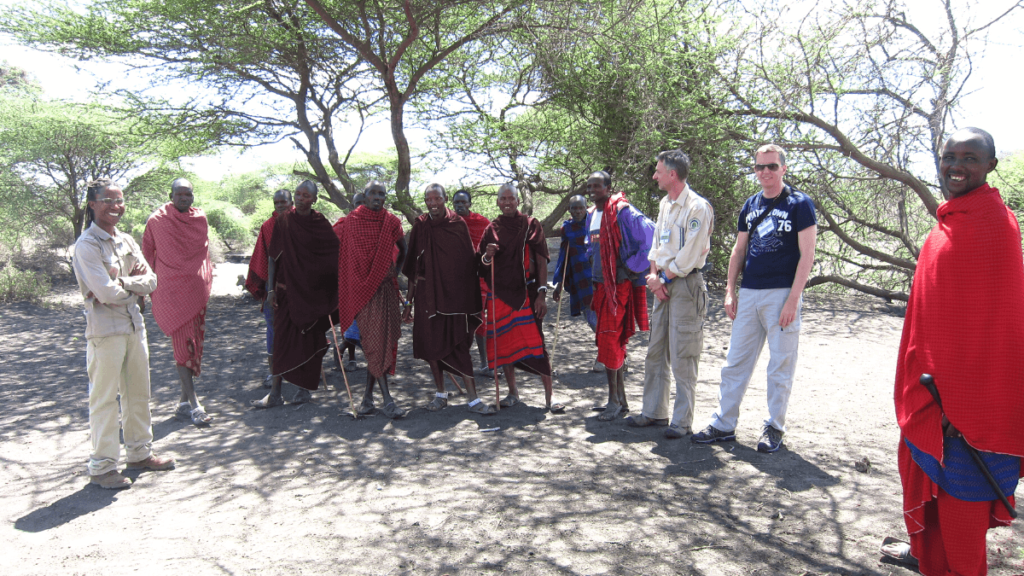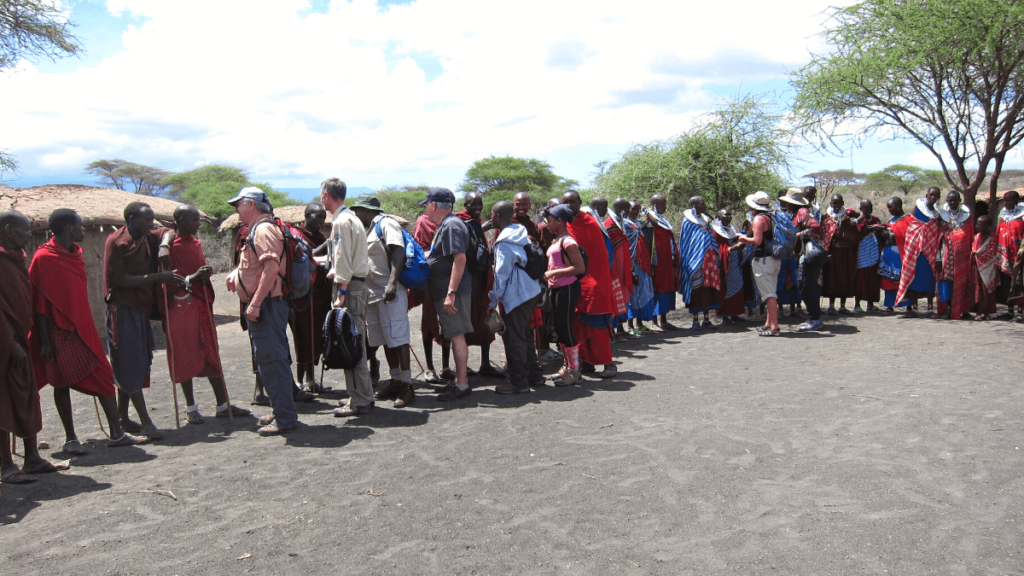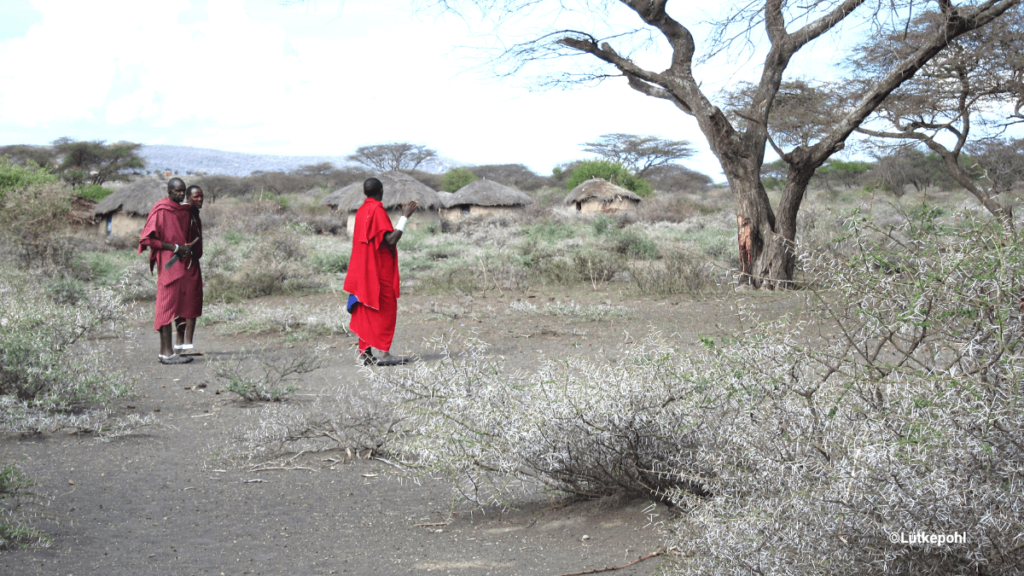As long-time head of the “Naturwacht Brandenburg” in Germany with 15 large protected areas, Manfred Lütkepohl is well aware of the issue of conflicts of interest with the local population. To this day, the ranger is interested in human rights of indigenous people worldwide. He is following the expulsion of the Maasai people in Tanzania from newly established, so-called protected areas with great concern.
In the interview, he talks about what he knows about the human rights violations there, how the international ranger community can help and why protected areas can only be successful in Europe, too, through a good balance of interests between the local population and the protection of biodiversity.

“Rangers around the world are the ones in contact with locals. Ideally, they are mediators between interests and rights of residents and protected area management.”
Manfred Lütkepohl, Ranger and former head of Naturwacht Brandenburg, Germany
Rangers all over the world repeatedly face conflicts with the local population, who are usually directly affected by nature reserves. What are the most typical conflicts?
Ever since the first national parks were designated in the USA in the 19th century, there has been displacement and deportation of indigenous populations. Right up to the present day, the designation of large protected areas has repeatedly interfered with the rights of people living there who previously used the natural resources of the areas. These are, for example, grazing land, huntable game, fish and plants. Rangers around the world are the ones who are on the ground and in contact with the local population. Ideally, they are mediators between the interests and rights of the population and the protected area management.
A current example is Tanzania: Here, Maasai are being driven out of their villages because a protected area is to be established on their territory. What is the situation like and how is the role of the rangers to be assessed?
On the one hand, this is about the Loliondo area in the neighbourhood of Serengeti. It is inhabited by the Maasai. According to information from the “Gesellschaft für bedrohte Völker” (Society for Threatened Peoples), it is to be converted into a game reserve and should primarily attract hunting tourists – against this background, it already seems doubtful what value nature conservation will have there. The Maasai will no longer be allowed to live here, and evictions have already begun. Until now, 70,000 people lived in this area. They are mainly being evicted by police forces, but rangers from the Serengeti National Park have also been involved in burning down Maasai huts. According to a report in the weekly newspaper “Die Zeit”, a total of 80,000 Maasai are also to be resettled from the Ngorongoro National Park.
This eviction breaks international guidelines for the protection of human rights, including the Declaration on the Rights of Indigenous Peoples, which Tanzania also voted for. These evictions are not actually the rangers’ job. They are in a particularly difficult situation: on the one hand, the state is their employer. On the other hand, I think the rangers are in a conflict because the rights of indigenous peoples and local communities are being violated. This is also against the code of conduct of the International Ranger Federation, which the member organisations have agreed to. Unfortunately, there is no ranger organisation in Tanzania at the moment to which the rangers can turn to demand that the government stop the evictions.
What opportunities are there in the international ranger community to advocate for the Maasai and the fulfilment of human rights for indigenous peoples?
We in Europe cannot be indifferent to what is happening to the Maasai. We must support the International Ranger Federation in standing up for human rights in protected areas. It must be self-evident that the protection of biodiversity and the protection of human rights have the same value. The World Ranger Congresses have addressed the situation of indigenous peoples in protected areas and discussed how they can be included in protected area management. This should remain an important topic at future congresses. And of course, individual rangers and their organisations can also work with human rights organisations that have links to the United Nations Human Rights Council. In Germany, for example, this includes the Society for Threatened Peoples. Regarding the situation in Tanzania, the IRF recommends becoming active through the Game Rangers Association of Africa. This organisation is good at gathering information on the ground and together we can see which paths make the most sense.


In this context, human rights activists are highly critical of the international agreement reached last December to place 30 percent of the world’s land and sea under protection by 2030. Does it give a boost to human rights violations?
The “how” is indeed the decisive factor. Of course, human rights violations must never take place when new protected areas are designated. The management must also work well with the local communities whose areas are affected. There are now forms of co-management between indigenous groups and protected area administration, for example in Canada. Both sides are practically on an equal footing, and the inhabitants of protected areas can put forward their interests well. I think protected areas that are designated in populated regions can only function through such models.
What conflicts of interest do rangers in Europe have to deal with when it comes to residents of protected areas?
Of course, the local population and land users are also strongly affected by the designation of large protected areas. The better these people can bring their interests into the process, the better the acceptance of the protected area. The last GDR government, for example, placed around 10 percent of the country’s territory under protection. That was done in a mad rush because the necessary legal regulations had to be ready by the time of reunification. The population was therefore not adequately involved.
“The population was not adequately involved in establishing protected areas in GDR before reunification. But needs were taken into account afterwards and cooperation between protected area administrations, rangers and locals in Brandenburg is working well today.”
Manfred Lütkepohl, Ranger and former head of Naturwacht Brandenburg, Germany
Protected area administration and rangers were asked to heal this afterwards – a often painful process, because in the beginning there was little acceptance for the protected areas. But needs were taken into account afterwards, for example by allowing traditional bathing spots to be used now after all. And the population has recognised that tourism in the protected areas opens up new income opportunities and offers such as junior ranger or volunteer programmes. In the meantime, I can say, at least for Brandenburg, that the process has been successful and that the cooperation between protected area administrations, rangers and the local population is working well.
This content is sponsored by

“Vertreibung der Maasai kann uns nicht egal sein”
Als langjähriger Leiter der Naturwacht Brandenburg mit 15 Großschutzgebieten kennt Manfred Lütkepohl sich beim Thema Interessenkonflikte mit der lokalen Bevölkerung aus. Bis heute interessiert sich der Ranger für die Menschenrechte der indigenen Bevölkerung weltweit. Mit großer Sorge verfolgt er die Vertreibung des Maasai-Volks in Tansania aus neu eingerichteten, sogenannten Schutzgebieten.
Im Interview spricht er darüber, was er über die Menschenrechtsverletzungen dort weiß, wie die internationale Rangergemeinschaft helfen kann und weshalb Schutzgebiete auch in Europa nur durch guten Interessenausgleich zwischen der örtlichen Bevölkerung und dem Schutz der Biodiversität erfolgreich sein können.
Ranger stehen weltweit immer wieder vor Konflikten mit der lokalen Bevölkerung, die von Naturschutzgebieten meist unmittelbar betroffen sind. Was sind die typischsten Konflikte?
Schon seit im 19. Jahrhundert in den USA die ersten Nationalparks ausgewiesen wurden, kam es zu Vertreibung und Deportation indigener Bevölkerung. Bis in die Gegenwart wird bei der Ausweisung von Großschutzgebieten immer wieder in die Rechte dort lebender Menschen eingegriffen, die vorher die natürlichen Ressourcen der Gebiete genutzt haben. Das sind zum Beispiel Weideland, jagdbares Wild, Fische und Pflanzen. Ranger weltweit sind dabei diejenigen, die vor Ort unterwegs sind und den Kontakt zur Bevölkerung haben. Idealerweise sind sie Mittler zwischen den Interessen und Rechten der Bevölkerung und dem Schutzgebietsmanagement.
Ein aktuelles Beispiel ist Tansania: Hier werden Maasai aus ihren Dörfern vertrieben, weil auf ihrem Gebiet ein Schutzgebiet eingerichtet werden soll. Wie ist die Situation dort, und wie ist die Rolle der Ranger hier zu beurteilen?
Hier geht es zum einen um das Gebiet Loliondo in der Nachbarschaft der Serengeti. Es wird von den Maasai bewohnt. Nach Informationen der Gesellschaft für bedrohte Völker soll es in ein Wildreservat umgewandelt werden und vor allem Jagdtouristen anziehen – vor diesem Hintergrund scheint schon zweifelhaft, welchen Stellenwert Naturschutz dort haben wird. Den Maasai ist es künftig nicht mehr gestattet, hier zu leben, und die Vertreibungen haben bereits begonnen. Bisher lebten 70.000 Menschen in diesem Gebiet. Sie werden überwiegend von Polizeikräften vertrieben, aber auch Ranger des Serengeti-Nationalparks waren am Niederbrennen von Hütten der Maasai beteiligt. Nach einem Bericht der Wochenzeitung “Die Zeit” sollen außerdem auch aus dem Ngorongoro-Nationalpark insgesamt 80.000 Maasai umgesiedelt werden. Diese Vertreibung bricht internationale Richtlinien zum Schutz von Menschenrechten, unter anderem die Deklaration für die Rechte indigener Bevölkerungsgruppen, für die auch Tansania gestimmt hat. Diese Vertreibungen sind eigentlich nicht Aufgabe der Ranger. Sie sind in einer besonders schwierigen Situation: Zum einen ist der Staat ihr Arbeitgeber. Zum anderen denke ich, die Ranger befinden sich in einem Konflikt, weil die Rechte indigener Völker und lokaler Gemeinden verletzt werden. Das verstößt auch gegen den Verhaltenskodex der International Ranger Federation, dem die Mitgliedsorganisationen zugestimmt haben. Leider gibt es in Tansania momentan aber keine Rangerorganisation, an die sich die Ranger wenden könnten, damit diese von der Regierung ein Ende der Vertreibungen fordert.
Welche Möglichkeiten gibt es in der internationalen Rangergemeinschaft, sich für die Maasai und die Einhaltung der Menschenrechte für indigene Völker stark zu machen?
Auch uns in Europa kann das, was den Maasai passiert, nicht egal sein. Wir müssen die International Ranger Federation dabei unterstützen, sich für die Menschenrechte in Schutzgebieten stark zu machen. Es muss selbstverständlich sein, dass der Schutz der Biodiversität und der Schutz von Menschenrechten die gleiche Wertigkeit haben. Die Weltrangerkongresse haben die Situation von Indigenen in Schutzgebieten thematisiert und diskutiert, wie sie in das Schutzgebietsmanagement einbezogen werden können. Das sollte auch bei künftigen Kongressen ein wichtiges Thema bleiben. Und natürlich können auch einzelne Ranger und ihre Organisationen mit Menschenrechtsorganisationen zusammenarbeiten, die Verbindung zum United Nations Human Rights Council haben. Dazu gehört in Deutschland zum Beispiel die Gesellschaft für bedrohte Völker. Zur Situation in Tansania empfiehlt die IRF, über die Game Rangers Association of Africa aktiv zu werden. Diese Organisation kann vor Ort gut Informationen sammeln und man kann gemeinsam schauen, welche Wege am sinnvollsten sind.
Menschenrechtler sehen in diesem Zusammenhang die im vergangenen Dezember erzielte internationale Vereinbarung überaus kritisch, bis 2030 weltweit 30 Prozent der Landes- und Meeresfläche unter Schutz zu stellen. Gibt sie Menschenrechtsverletzungen Auftrieb?
Das “Wie” ist tatsächlich das Entscheidende. Menschenrechtsverletzungen dürfen bei Ausweisung neuer Schutzgebiete natürlich auf keinen Fall stattfinden. Das Management muss außerdem gut mit den lokalen Gemeinschaften zusammenarbeiten, deren Areale betroffen sind. Inzwischen gibt es Formen von Co-Management zwischen indigenen Gruppen und Schutzgebietsverwaltung, etwa in Kanada. Beide Seiten sind praktisch gleichberechtigt, und die Bewohner von Schutzgebieten können ihre Interessen gut einbringen. Ich denke, Schutzgebiete, die in besiedelten Regionen ausgewiesen werden, können nur über solche Modelle funktionieren.
Mit welchen Interessenkonflikten haben Ranger in Europa es mit Blick auf Anwohner von Schutzgebieten zu tun?
Starke Betroffenheiten der örtlichen Bevölkerung und Landnutzer bestehen bei der Ausweisung von Großschutzgebieten natürlich auch bei uns. Je besser diese Menschen ihre Interessen in die Entstehung einbringen können, desto besser ist die Akzeptanz des Schutzgebiets. Die letzte DDR-Regierung zum Beispiel hat rund 10 Prozent der Landesfläche unter Schutz gestellt. Das lief wahnsinnig hektisch, weil die notwendigen gesetzlichen Regelungen bis zur Wiedervereinigung fertig sein mussten. Die Bevölkerung wurde deshalb nicht angemessen beteiligt. Schutzgebietsverwaltung und die Ranger waren hinterher gefragt, das zu heilen – ein vielfach schmerzlicher Prozess, denn anfangs gab es wenig Akzeptanz für die Schutzgebiete. Aber es sind im Nachhinein noch Bedürfnisse berücksichtigt worden, etwa indem traditionelle Badestellen nun doch genutzt werden dürfen. Und die Bevölkerung hat erkannt, dass der Tourismus in den Schutzgebieten neue Einkommensmöglichkeiten eröffnet und ihnen Angebote wie Junior-Ranger- oder Freiwilligenprogramme offenstehen. Inzwischen kann ich zumindest für Brandenburg sagen, dass der Prozess gelungen ist und das Miteinander zwischen Schutzgebietsverwaltungen, Rangern und örtlicher Bevölkerung gut funktioniert.

